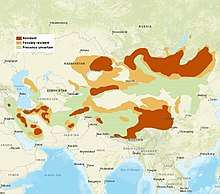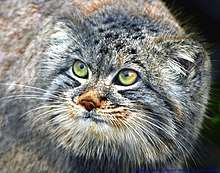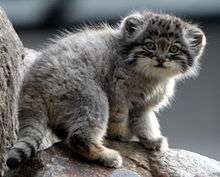Pallas's cat
Pallas's cat (Otocolobus manul), also called the manul, is a small wild cat with a broad, but fragmented distribution in the grasslands and montane steppes of Central Asia. It is negatively affected by habitat degradation, prey base decline and hunting. It has been classified as Least Concern on the IUCN Red List since 2020.[1]
| Pallas's cat | |
|---|---|
 | |
| A manul at Rotterdam Zoo | |
| Scientific classification | |
| Kingdom: | Animalia |
| Phylum: | Chordata |
| Class: | Mammalia |
| Order: | Carnivora |
| Suborder: | Feliformia |
| Family: | Felidae |
| Subfamily: | Felinae |
| Genus: | Otocolobus Brandt, 1841 |
| Species: | O. manul[2] |
| Binomial name | |
| Otocolobus manul[2] (Pallas, 1776) | |
 | |
| Distribution of Pallas's cat in 2016[1] | |
The Pallas's cat was first described in 1776 by the German naturalist Peter Simon Pallas.[3][4]
Taxonomy
Felis manul was the scientific name used by Peter Simon Pallas in 1776, who first described a Pallas's cat that he had encountered during his travels in eastern Siberia.[3][4] Several Pallas's cat zoological specimens were subsequently described:
- Felis nigripectus proposed by Brian Houghton Hodgson in 1842 was based on three specimens from Tibet.[5]
- Otocolobus manul ferrugineus proposed by Sergey Ognev in 1928 was a specimen from the Transcaspian region.[6]
Otocolobus was proposed by Johann Friedrich von Brandt in 1842 as generic name.[7][8] Reginald Innes Pocock recognized the taxonomic classification of Otocolobus in 1907, described several Pallas's cat skulls in detail, and considered the Pallas's cat an aberrant form of Felis.[9]
In the 1960s, John Ellerman and Terence Morrison-Scott considered
- the nominate subspecies Felis manul manul occurring from Jida River south of Lake Baikal to eastern Siberia;[10]
- F. m. nigripecta occurring in Tibet and Kashmir;[10]
- F. m. ferruginea occurring in the mountain ridge of Missanev, Kopet-Dag Mountains, Transcaspia, southwestern Turkestan, northern Iran, Baluchistan and Afghanistan.[10]
Since 2017, the Cat Classification Task Force of the Cat Specialist Group recognises only two subspecies as valid taxa, namely:[11]
- O. m. manul syn. O. m. ferrugineus in the western and northern part of Central Asia from Iran to Mongolia;
- O. m. nigripectus in the Himalayas from Kashmir to Bhutan.
Phylogeny
Phylogenetic analysis of the nuclear DNA in tissue samples from all Felidae species revealed that the evolutionary radiation of the Felidae began in Asia in the Miocene around 14.45 to 8.38 million years ago.[12][13] Analysis of mitochondrial DNA of all Felidae species indicates a radiation at around 16.76 to 6.46 million years ago.[14] The Pallas's cat is estimated to have genetically diverged from a common ancestor with the genus Prionailurus between 8.55 to 4.8 million years ago, based on analysis of nuclear DNA.[12] and 9.4 to 1.46 million years ago based on analysis of mitochondrial DNA.[14]
Characteristics

The Pallas's cat is about the size of a domestic cat. Its body is 46 to 65 cm (18 to 26 in) long and its tail 21 to 31 cm (8.3 to 12.2 in). It weighs 2.5 to 4.5 kg (5.5 to 9.9 lb). The combination of its stocky posture and long, dense fur makes it appear stout and plush. Its fur is ochre with dark vertical bars on the torso and forelegs. The winter coat is greyer and less patterned than the summer coat. There are clear black rings on the tail and dark spots on the forehead. The cheeks are white with narrow black stripes running from the corners of the eyes. The chin and throat are also white, merging into the greyish, silky fur of the underparts. Concentric white and black rims around the eyes accentuate their rounded shape. The legs are proportionately shorter than those of other cats, the ears are set very low and wide apart, and the claws are unusually short. The face is shortened compared with other cats, giving it a flattened look. The pupils are circular rather than vertical slits. The short jaw has fewer teeth than is typical among cats, with the first pair of upper premolars missing, but the canine teeth are large.[15]
Distribution and habitat
The Pallas's cat is native to the steppe regions of Central Asia, where it inhabits elevations of up to 5,050 m (16,570 ft) on the Tibetan Plateau.[16] It also lives in parts of Kazakhstan, Tajikistan, Kyrgyzstan, Iran, Afghanistan, Pakistan, Nepal, India, Bhutan and Mongolia, and occur across much of western China. In the south of Russia it lives in the Transbaikal Krai, and alos in the Altai, Tyva, and Buryatia Republics.[1] In 1997, it was reported for the first time as being present in the eastern Sayan Mountains.[17]
Until the early 1970s, only two Pallas's cats were recorded in the Transcaucasus, both encountered near the Aras River in northwestern Iran.[18] Populations in the Caspian Sea region, in Afghanistan and Pakistan, are thought to be declining and becoming increasingly isolated.[19][20]
In the 21st century, several Pallas' cats were photographed for the first time during camera trapping surveys:
- in Iran's Khojir National Park in 2008;[21]
- in the Eastern Himalayas: in Bhutan's Wangchuck Centennial Park in April 2012;[22] and above 4,100 m (13,500 ft) in Jigme Dorji National Park in autumn 2012;[23]
- in Pakistan's Qurumber National Park above 3,400 m (11,200 ft) in July 2012;[24]
- in Nepal's Annapurna Conservation Area above 4,200 m (13,800 ft) in December 2012 and December 2013.[25]
In Ladakh's Changthang Wildlife Sanctuary, Pallas's cats were sighted near Hanle River at an elevation of 4,202 m (13,786 ft) in 2013, and at 4,160 m (13,650 ft) in 2015.[26]
Behaviour and ecology

Pallas's cats are solitary. Both males and females scent mark their territory. They spend the day in caves, rock crevices, or marmot burrows, and emerge in the late afternoon to begin hunting. They are not fast runners, and hunt primarily by ambush or stalking, using low vegetation and rocky terrain for cover. They feed largely on diurnally active prey species such as gerbils, pikas, voles and chukar partridges, and sometimes catch young marmots.[15]
Reproduction
The breeding season is relatively short due to the extreme climate in the cat's native range. Estrus lasts between 26 and 42 hours, which is also shorter than in many other felids. Pallas's cats give birth to a litter of around two to six kittens after a gestation period of 66 to 75 days, typically in April or May. Such large litters may compensate for a high rate of infant mortality in the harsh environment. The young are born in sheltered dens lined with dried vegetation, feathers, and fur. The kittens weigh around 90 g (3.2 oz) at birth, and have a thick coat of fuzzy fur, which is replaced by the adult coat after around two months. They are able to begin hunting at four months, and reach adult size at six months. Pallas's cats have been reported to live up to 11 years in captivity.[15]
Threats
The Pallas's cat has been hunted for its fur in relatively large numbers in China, Mongolia, and Russia; international trade in manul pelts largely ceased since the late 1980s.[27] About 1,000 hunters of Pallas's cats remain in Mongolia, with a mean estimated take of 2,000 cats per year. Cats are also shot when mistaken for the commonly hunted marmot, and trapped incidentally in both legholds set for wolves and foxes and snares set for marmots and hares. They are also killed by herding dogs. While Mongolia has not recorded any trophy exports, pelt exports have grown since 2000, with 143 reported exported in 2007.[1]
Conservation
The Pallas's cat is listed in CITES Appendix II. Hunting is prohibited in all range countries except Mongolia, where the species has no legal protection. Since 2009, it is legally protected in Afghanistan, where all hunting and trade in its parts is banned.[1]
The cat is being studied in the Daursky Nature Reserve in Russia to obtain new information about habitats and migrations, and to estimate the survival rate of kittens and adult cats.[28]
In captivity

As of 2010, there were 47 Pallas's cats in 19 member institutions of the Association of Zoos and Aquariums; four litters were expected. No births and three deaths occurred in 2009. The 30-day mortality of 44.9% is the highest mortality rate of any small wild cat. The seasonality of its reproduction makes it difficult to control reproductive cycles.[29] Keeping Pallas's cats healthy in captivity is difficult. They breed well, but survival rates are low owing to infections, which are attributed to an underdeveloped immune system and exposure to viruses not present in their natural high-altitude habitat.[30]
In June 2010, five kittens were born in the Red River Zoo in Fargo.[31] A female was artificially inseminated for the first time at the Cincinnati Zoo and gave birth to three kittens in June 2011.[32] In May 2013, three kittens were born at the Nordens Ark zoo.[33] In May 2016, four kittens were born at the Korkeasaari zoo.[34] In March 2017, five kittens were born in the Hogle Zoo. In April 2017, five kittens were again born in the Red River Zoo in Fargo.[35] In April 2019, Miller Park Zoo announced five kittens; their father was imported from the Czech Republic.[36]
Etymology
The Pallas's cat alternate name 'manul' is the Kyrgyz word for the cat. In Mongolian language, it is called 'manol'.[4] The name 'Pallas's cat' was coined by William Thomas Blanford.[37] The alternate spelling 'Pallas’ cat' is also used.
References
- Ross, S.; Barashkova, A.; Dhendup, T.; Munkhtsog, B.; Smelansky, I.; Barclay, D. & Moqanaki, E. (2020). "Otocolobus manul". IUCN Red List of Threatened Species. 2020: e.T15640A162537635. Retrieved 10 July 2020.
- Wozencraft, W.C. (2005). "Felis manul". In Wilson, D.E.; Reeder, D.M (eds.). Mammal Species of the World: A Taxonomic and Geographic Reference (3rd ed.). Johns Hopkins University Press. p. 535. ISBN 978-0-8018-8221-0. OCLC 62265494.
- Pallas, P. S. (1776). "Felis manul". Reise durch verschiedene Provinzen des russischen Reichs in einem ausführlichen Auszuge. Volume 3. Frankfurt und Leipzig: J. G. Fleischer. p. 692.
- Pallas, P. S. (1811). "Felis Manul". Zoographia Rosso-Asiatica, sistens omnium Animalium in extenso Imperio Rossico et adjacentibus maribus observatorum recensionem, domicillia, mores et descriptiones, anatomen atque icones plurimorum. Volume 1. Petropoli: Officina Caes. Acadamiae scientiarum. pp. 20–23.
- Hodgson, B. H. (1842). "Notice of the Mammals of Tibet, with Description and Plates of some new Species: Felis nigripectus Illustration". Journal of the Asiatic Society of Bengal. 11 (1): 275–289, Plate 333.
- Ognev, S. I. (1928). "On a new form of the steppe cat from the Transcaspian region [Otocolobus manul ferrugineus]". Doklady Akademii Nauk Soyuza Sovetskikh Sotsialisticheskikh Respublik. Seriya A: 308–310.
- Brandt J. F. (1842). "Observations sur le manoul (Felis manul Pallas)". Bulletin Scientifique. Académie Impériale des Sciences de Saint Petersbourg. 9: 37–39.
- Severtzow, M. N. (1858). "Notice sur la classification multisériale des Carnivores, spécialement des Félidés, et les études de zoologie générale qui s'y rattachent". Revue et Magasin de Zoologie Pure et Appliquée. 2 (X): 385–393.
- Pocock, R. I. (1907). "Exhibition of a photograph and the skull of a specimen of the Manul or Pallas' cat (Felis manul) that had recently died in the Society's Menagerie with some remarks on the species". Proceedings of the Zoological Society of London: 299–306.
- Ellerman, J. R.; Morrison-Scott, T. C. S. (1966). "Felis manul Pallas, 1776". Checklist of Palaearctic and Indian mammals 1758 to 1946 (2nd ed.). London: British Museum of Natural History.
- Kitchener, A. C.; Breitenmoser-Würsten, C.; Eizirik, E.; Gentry, A.; Werdelin, L.; Wilting, A.; Yamaguchi, N.; Abramov, A. V.; Christiansen, P.; Driscoll, C.; Duckworth, J. W.; Johnson, W.; Luo, S.-J.; Meijaard, E.; O’Donoghue, P.; Sanderson, J.; Seymour, K.; Bruford, M.; Groves, C.; Hoffmann, M.; Nowell, K.; Timmons, Z.; Tobe, S. (2017). "A revised taxonomy of the Felidae: The final report of the Cat Classification Task Force of the IUCN Cat Specialist Group" (PDF). Cat News (Special Issue 11): 21−22.
- Johnson, W. E.; Eizirik, E.; Pecon-Slattery, J.; Murphy, W. J.; Antunes, A.; Teeling, E. & O'Brien, S. J. (2006). "The Late Miocene radiation of modern Felidae: A genetic assessment" (PDF). Science. 311 (5757): 73–77. Bibcode:2006Sci...311...73J. doi:10.1126/science.1122277. PMID 16400146.
- Werdelin, L.; Yamaguchi, N.; Johnson, W. E. & O'Brien, S. J. (2010). "Phylogeny and evolution of cats (Felidae)". In Macdonald, D. W. & Loveridge, A. J. (eds.). Biology and Conservation of Wild Felids. Oxford, UK: Oxford University Press. pp. 59–82. ISBN 978-0-19-923445-5.
- Li, G.; Davis, B. W.; Eizirik, E. & Murphy, W. J. (2016). "Phylogenomic evidence for ancient hybridization in the genomes of living cats (Felidae)". Genome Research. 26 (1): 1–11. doi:10.1101/gr.186668.114. PMC 4691742. PMID 26518481.
- Sunquist, M. & Sunquist, F. (2002). "Manul Otocolobus manul (Pallas 1776)". Wild Cats of the World. Chicago: University of Chicago Press. pp. 219–224. ISBN 978-0-226-77999-7.
- Fox, J. L. & Dorji, T. (2007). "High elevation record for occurrence of the manul or Pallas' Cat on the northwestern Tibetan plateau, China". Cat News (46): 35.
- Koshkarev, E. (1998). "Discovery of manul in eastern Sayan". Cat News (29): 12–13.
- Geptner, V. G. & Sludskii, A. A. (1992) [1972]. "Manul. Felis (Otocolobus) manul Pallas, 1776". Mlekopitaiuščie Sovetskogo Soiuza. Vysšaia Škola, Moskva [Mammals of the Soviet Union. Volume II, Part 2: Carnivora (Hyaenas and Cats)]. Washington, D.C.: Smithsonian Institution and the National Science Foundation. pp. 665–696.
- Belousova, A. V. (1993). "Small Felidae of Eastern Europe, Central Asia and Far East. Survey of the state of populations". Lutreola. 2: 16.
- Habibi, K. (2003). Mammals of Afghanistan. Coimbatore, India: Zoo Outreach Organisation with assistance from U.S. Fish and Wildlife Service. ISBN 978-8188722068. OCLC 61347929.
- Chalani, M.; Ghoddousi, A.; Ghadirian, T. & Goljani, R. (2008). "First Pallas's Cat Photo-trapped in Khojir National Park, Iran". Cat News (49): 7.
- WWF Bhutan (2012). Near threatened Pallas' Cat found in WCP (Report). Wangchuck Centennial Park and WWF.
- Thinley, P. (2013). "First photographic evidence of a Pallas's cat in Jigme Dorji National Park, Bhutan". Cat News (58): 27–28.
- Hameed, S.; Ud Din, J.; Shah, K. A.; Kabir, M.; Ayub, M.; Khan, S.; Bischof, R.; Nawaz, D. A.; Nawaz, M. A. (2014). "Pallas's cat photographed in Qurumber National Park, Gilgit-Baltistan, Pakistan". Cat News (60): 21–22.
- Shrestha, B.; Ale, S.; Jackson, R.; Thapa, N.; Gurung, L. P.; Adhikari, S.; Dangol, L.; Basnet, B.; Subedi, N. & Dhakal, M. (2014). "Nepal's first Pallas's cat". Cat News (60): 23–24.
- Mahar, N.; Shrotriya, S.; Habib, B.; Singh, S.; Takpa, J. & Hussain, S. A. (2017). "Recent records of the Pallas's Cat in Changthang Wildlife Sanctuary, Ladakh, India". Cat News (65): 36–37.
- Nowell, K.; Jackson, P. (1996). "Manul Octobulus manul (Pallas, 1776)". Wild Cats: status survey and conservation action plan. IUCN/SSC Cat Specialist Group, Gland, Switzerland.
- Barashkova, A.N.; Kirilyuk, V.E. & Smelansky, I.E. (2017). "Significance of Protected Areas for the Pallas's Cat (Otocolobus manul Felidae) Conservation in Russia" (PDF). Заповедная наука [Nature Conservation Research]. 2 (Supplement 1): 113–124.
- Bray, S. (May 2010). "Pallas' Cat PMP" (PDF). Felid TAG Times. 3.
- Smith, S. (2008). "Himalayan kitten at park" (Video). BBC News.
- "ND zoo officials boast litter of 5 Pallas kitten". WDAY News. Associated Press. 2010.
- CREW (2011). "Pallas' cats born from artificial insemination". Cincinnati Zoo's Center for Conservation and Research of Endangered Wildlife.
- Bohusläningen (2013). "pallaskatterna har fått ungar". Bohusläningen.
- "Manuli – Korkeasaaren eläintarha" (in Finnish). Retrieved 2016-09-26.
- "A purr-fect result: 5 rare Pallas cats born at Red River Zoo". Retrieved 2017-05-11.
- "Miller Park Zoo Welcomes 5 Pallas Cat Kittens". 2019. Retrieved 2019-04-24.
- Blanford, W. T. (1888–1891). "Felis manul. Pallas's Cat". The fauna of British India, including Ceylon and Burma. Mammalia. London: Taylor & Francis. pp. 83–84.
External links
| Wikimedia Commons has media related to Pallas's cat. |
| Wikispecies has information related to Pallas's cat |
- "Pallas's cat Otocolobus manul". IUCN/SSC Cat Specialist Group.
- "Pallas' Cat Working Group".
- "Pallas' Cat Study and Conservation Program".
- "The Pallas's Cat". Indian Tiger Welfare Society archive.
